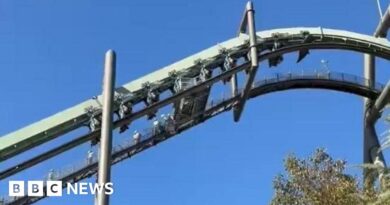Widening Mideast Crisis: Drone Strike Kills 3 U.S. Soldiers in Jordan, White House Says
[ad_1]
Three U.S. service members were killed in Jordan on Sunday and 25 others were injured in what the Biden administration said was a drone strike from an Iran-backed militia, the first American military fatalities from hostile fire in the turmoil spilling over from Israel’s war with Hamas.
The attack happened at a remote outpost in northeast Jordan called Tower 22 near the Syria border, where the troops were based. Other details were not immediately available from the Pentagon’s Central Command, which issued an initial bare-bones statement on Sunday.
But the deaths of U.S. service members will almost certainly increase pressure on President Biden to respond more forcefully as strife grows in the Middle East after the Oct. 7 attacks that killed 1,200 people in Israel.
“Three U.S. service members were killed — and many wounded — during an unmanned aerial drone attack on our forces stationed in northeast Jordan near the Syria border,” Mr. Biden said in a statement on Sunday. “While we are still gathering the facts of this attack, we know it was carried out by radical Iran-backed militant groups operating in Syria and Iraq.”
Speaking later in Columbia, S.C., Mr. Biden said, “We lost three brave souls.” The president then led a moment of silence, before adding, “We shall respond.”
Defense Secretary Lloyd J. Austin III also held Iran-backed militias responsible for the continued attacks against U.S. troops in the region. “The president and I will not tolerate attacks on American forces, and we will take all necessary actions to defend the United States, our troops and our interests,” Mr. Austin said.
The Pentagon declined to identify the service members who died or their units pending notification of family members.
In a statement, the Iran-backed militias who call themselves the Axis of Resistance claimed responsibility for the attack on the base in a remote desert area of Jordan, saying it was a “continuation of our approach to resisting the American occupation forces in Iraq and the region.”
The drone strike came as Israel and Hezbollah, another Iranian ally, have traded fire across the Lebanese border. A Houthi militia in Yemen, also backed by Iran, has fired missiles and drones at commercial ships in the Red Sea and the Gulf of Aden, calling it a retaliation for the Israeli bombardment of Gaza. The United States and its allies have fired back, striking inside Yemen at least 10 times.
And on Jan. 20, at least four U.S. service members stationed in western Iraq were injured when their air base came under heavy rocket and missile fire from what American officials said were Iran-backed militias. It was the latest in more than 150 strikes by Iran-backed militias in Syria and Iraq against U.S. troops there since the Oct. 7 attacks.
Until Sunday’s deadly attack, senior administration officials said that only luck had spared the United States from more serious casualties. One drone packed with explosives landed on a barracks at the Erbil air base in Iraq on Oct. 25. It turned out to be a dud, but several service members would most likely have been injured or killed had it exploded, a senior military official said.
The drone strike in Jordan on Sunday demonstrated that the Iran-backed militias — whether in Iran or Syria, or the Houthis in Yemen — remained capable of inflicting serious consequences on American troops despite the U.S. military’s efforts to weaken them and avoid tumbling into a wider conflict, possibly with Iran itself.
“We don’t want to go down a path of greater escalation that drives to a much broader conflict within the region,” Gen. Charles Q. Brown Jr., the chairman of the Joint Chiefs of Staff, said on Sunday.
Asked in a prerecorded session on ABC News’s “This Week” whether he thought Iran wanted war with the United States, General Brown, echoing assessments from the U.S. intelligence agencies, said, “No, I don’t think so.”
In his statement, Mr. Biden called the fallen U.S. troops “patriots in the highest sense,” and said they were “risking their own safety for the safety of their fellow Americans, and our allies and partners with whom we stand in the fight against terrorism. It is a fight we will not cease.”
Last Sunday, the Pentagon declared two members of the Navy SEALs dead after they disappeared 10 days earlier during an operation at sea to intercept weapons from Iran headed to Houthi fighters.
The Navy commandos were the first known U.S. fatalities in Washington’s campaign against the Houthis, who from territory they control in the country’s north have launched dozens of attacks on ships in the Red Sea since November, roiling the global shipping industry.
The Americans killed on Sunday were the first known fatalities from hostile fire in the region since the Oct. 7 attacks by Hamas.
The U.S. troops at the Tower 22 border outpost advise and assist Jordanian troops in counterterrorism missions, and provide support for the Al Tanf garrison just across the border in southeastern Syria. The United States also has about 2,000 troops stationed at an air base in Azraq, Jordan, as well as Special Operations forces and military trainers.
It was unclear on Sunday why air defenses at the outpost failed to intercept the drone, which current and former military commanders said appeared to be the first known assault on the location since attacks on U.S. forces began soon after the Oct. 7 incursion.
In 2016, the American military turned Al Tanf into a small base. It is on the strategic Baghdad-Damascus highway — a vital link for forces backed by Syria’s ally Iran in a corridor that runs from the Iranian capital, Tehran, through Iraq and Syria to southern Lebanon.
The Rukban refugee camp, with some 8,000 residents, is near both Al Tanf and Tower 22.
Troops at Al Tanf have come under fire before from Iran-backed militias. The Defense Department said last fall that 21 troops had suffered minor injuries but returned to duty after the attacks on Oct. 17 and 18 at Al Asad Air Base in western Iraq and the Al Tanf garrison.
Alissa J. Rubin contributed reporting from New York, and Zolan Kanno-Youngs from Charlotte, N.C.
[ad_2]




